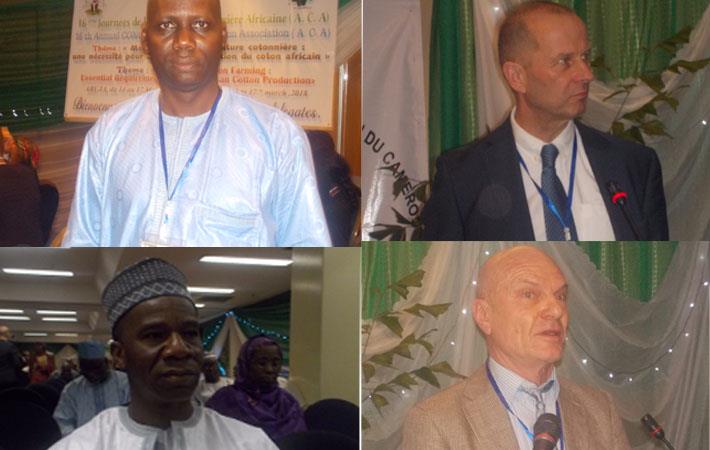Global interest in African cotton growing

Global interest in Africa is growing. The US and Russia don’t want to be sidelined in the Dark Continent by strategic super-investor China. At the level of companies, Turks and Indians are eagerly competing with companies from the former European colonisers.
However, the basic motivation of most foreign players tends to be one-sided : ‘What can Africa offer us?’ (and not that much the reverse). That attitude has a negative effect on the mechanisation of the African cotton-farming sector. Mechanised cotton production in Africa is a huge challenge. But it’s not perceived as an international issue. It’s an African issue.
The African Cotton Association (ACA) dedicated its 16th annual Congress to the analysis and discussion of a vital sector problem: how to make progress in the mechanisation of African cotton farming? Numerous delegates of African cotton associations, cotton experts and suppliers of cotton inputs met from March 13 to 15 in Nigerian capital Abuja.
Over the years, delegates of the associations have become good friends. Some of them must have common souvenirs as ‘comrades in arms’. In 2003, four African cotton producers (Benin, Burkina Faso, Chad, and Mali, the so-called C-4) joined forces to argue that cotton subsidies, especially in the US and EU, caused world cotton prices to decline and reduced their export revenues. The C4 proposition failed, but in 2013 they forwarded a second proposal for cotton during the WTO Ministerial Conference in Bali. So, they helped launch the Bali Package, an accord that included provisions for lowering import tariffs and agricultural subsidies.
During the 2018 African Cotton Conference in Abuja, which as usually was well prepared by ACA Permanent Secretary Adéyémi Fahala (Benin) and gracefully presided over by Chairman Baba Berthe (Mali), participants limited themselves to providing presentations and exchanging views. They apparently didn’t feel urged enough to discuss pan-African solutions or to agree on coordinated actions. It looks as if each African cotton country is OK with waging its own solitary fight.
A pillar of national economies
From a global perspective, African cotton is not very important. The continent’s annual cotton exports are worth around $1.2 billion, according to statistics compiled by the Swiss-based International Trade Centre. In 2017–18, as a producer of cotton, Africa is ranking only sixth after India, China, the US, Pakistan and Brazil. However, Africa produces more cotton than countries like Australia, Turkey or Uzbekistan. As a cotton fibre exporter, Africa remains an important international player because most of its cotton lint is not transformed locally into textiles, but just exported.
Especially in the Western and Central African countries, the cotton sector is a major employer and a pillar of the national economy. In Western and Central Africa, an estimated 10 million people depend on cotton for their livelihoods. It’s estimated that in Burkina Faso alone 350,000 farmers cultivate cotton and roughly 4 million Burkinabes depend on them.
In the whole of Africa, with the exception of South Africa, cotton farming is a low-productivity sector which is not able to provide small cotton farmers a worthy income. Farm productivity has to be strongly increased. In countries like Australia, Turkey, China and Brazil, the average yield of cotton easily exceeds 1,500 kg/ha. In Africa, it remains under 500 kg/ha; thus still lower than in other handpicking countries like India and Pakistan.
Sustainable mechanisation should be one of the main leverages to obtain a higher yield per hectare in Africa. Unfortunately, until now, mechanisation has been frequently neglected in farm productivity efforts. Anyway, for most cotton farmers mechanisation is out of the question. They don’t have the needed farm size, capital and skills. Ancillary services like fuel, spareparts or maintenance are often located far away from the cotton fields.
Lowest degree of mechanisation
Of all continents, Africa has the lowest degree of mechanisation in cotton farming. It is assumed that in Africa less than 10 per cent of cotton farm power comes from engine-powered sources. Approximately 25 per cent of farm power is provided by draught animals like oxen and mules and over 70 per cent comes from physical labour, mostly from women, the elderly and children. People working in the cotton fields have mostly only rudimentary tools and equipment at their disposal for soil preparation, crop care, bucket irrigation and transport of goods. Cotton farming in Africa is a matter of tough physical labour and human sweat just like it was in previous centuries.
French cotton consultant Gérald Estur, who’s every year one of the key speakers at the African Cotton Congress, pointed out that the slaves who before the American Civil War worked in southern cotton plantations were expected to work 4 ha of land and pick up to 90 kg of cotton a day. Today, African cotton farmers and their families do much the same work as American slaves of the 19th century.
Hard rural work is not a source of happiness. Influential French thinker Jean-Jacques Rousseau was wrong about that. Take Tanzania in East Africa. In Tanzania, over 75 per cent of the about 55 million inhabitants live in rural areas with agriculture as the mainstay of their income earnings. Most of them are smallholder farmers cultivating 0.2–2 hectare with low levels of mechanisation. Do they enjoy life? According to the World Happiness Index, Tanzania is one of the least happy countries in the world, ranking behind troubled countries like Libya, Syria and Yemen. Over the last few years, only a few countries suffering from civil strife like Burundi and Central African Republic scored lower on the World Happiness Index than Tanzania.
Lack of labour
Manual harvesting of cotton is labour intensive. According to international consulting company Sofreco, a worker can nowadays typically handpick around 15–50 kg of seed cotton per day depending on variety, yield and plant density. As a result, manual harvesting becomes a bottleneck for larger fields and higher yields. But adoption of mechanical harvest is not an overnight process: it took 30 years in the US to achieve 100 per cent machine harvesting.
The transition from handpicking to mechanised harvesting will require huge changes in the African farming system. Mechanical harvest requires suitable cotton varieties and higher plant density. Modern cotton pickers are only suitable for harvesting relatively large fields with high yield. Besides, they are expensive. Estur points out that a state-of-the art six-row cotton picker, with a field capacity of 3 hectare per hour, costs more than $600,000. Sofreco insists that cotton mechanisation is more than just putting machines into the fields. It is closely interlinked with other intensive production practices.
Mechanisation is needed not only to increase productivity but even more to improve life for African cotton farm workers. Without mechanisation, the cotton farming sector will increasingly become less attractive for young people who nowadays are better informed and connected than previous generations. If no progress would be made, the tough work will be shifted even more to the most disadvantaged people who can’t run away from the drudgery. Already today, in several cotton countries, due to the expansion of gold-washing, to the rural exodus to the cities and the school calendars, the cotton producers face a lack of labour during the harvest periods.
In Sub-Saharan Africa, especially Kenya, South Africa and Zimbabwe have been the trendsetters in agricultural mechanisation. However, a general stagnation and even backpedalling could be observed. Agricultural research tended to focus more on increasing efficiency with land, water and nutrients while mechanisation appeared to be forgotten.
Indian tractors for Africa
In spite of the low degree of motorisation of cotton farming in Africa, it appears that a lot of Indian tractors are at work in the sector, as well in East as in West Africa. The machinery and equipment supply system in East Africa has historically been dependent on imports, first from Europe, then from North America and recently from India, China, Vietnam and Iran.
In 2011, 1,800 Farmtrac tractors and 400 power tillers were imported by the Tanzanian government with a soft loan financed by the Government of India. The private sector expressed concern regarding the government’s interest in re-entering agricultural mechanisation in a large scale. In 1996 in Burkina Faso, around 345 tractors of the brand Hindustan (61 hp and 45 hp) have been acquired by cotton producers thanks to the project ‘National Unity of Mechanisation’. In 2007 and 2012, the ‘Team 9’ project allowed cotton farmers in Burkina Faso to acquire first 700 and then 125 Indian tractors.
In cooperation with Indian investors, the Government of Mali has installed a local assembly unit for tractors (Mali Tracteurs SA). Taking into account the weak demand, daily production of this factory doesn’t exceed 8–12 tractors and accessories.
A lot of constraints
Speakers at the ACA Congress in Abuja who made a SWOT analysis of the mechanisation of African cotton farming painted a rather dark picture. In spite of government efforts in several cotton countries, it can’t be expected that in the next years mechanisation will show quick progress. There are too many constraints, as well at the level of smallholder farmers as at village, national, African and even international level. For smallholder farmers, as individuals or as participants in local cooperatives, the constraint is mainly a lack of money and skills.
At national level, there are modest mechanisation programmes in several countries. But it mostly doesn’t look as if mechanisation of the sector is a big and permanent national priority.
At the African level, there’s surely a lack of cooperation. The African Cotton and Textile Industries Federation (ACTIF), headquarted in Nairobi, whose mission is to promote trade and increase market access for the African cotton, textiles and apparel industry (especially by organising the annual Origin Africa conference and trade show), and ACA each go their own way.
For visitors to Africa, it doesn’t take long to establish that Africa is far from being a united continent. For example, do you have Kenyan shillings left in your wallet when you fly from Kenya to neighbouring Ethiopia? Bad luck. No bank in Addis Ababa will accept your shillings to exchange them in Ethiopian birr.
On March 14, 2018, African leaders from 44 countries signed up to establish a huge African free trade block within 18 months. Will that be the start of a new era characterised by African unity leading to more inter-African investment and trade? Most observers are sceptical. The African Big Two, Nigeria and South Arica, stayed on the sidelines. Also other countries like Benin (cotton country) and Lesotho (apparel) stayed out of the block.
This would remind one of what Greek historian Thucydide had remarked: “You know as well as we do that right, as the world goes, is only in question between equals in power. The strong do what they want and the weak suffer what they must.” Sure, the US offered in 2000 the AGOA (African Growth and Opportunity Act) to Africa, but when in 2003 four West-African countries brought the unfairly high American cotton subventions up for discussion, the US preferred to initially remain deaf.
In 2008 Burkina Faso began the nationwide introduction of a variety of cotton containing Monsanto’s Bollgard II trait to fight against pests. However, it appeared that the fibre length, one of the chief measures of quality, was reduced when Monsanto introduced the gene into the country’s cotton. Monsanto apparently failed to do the appropriate number of backcrosses and tests to guarantee the Burkinese cotton farmers traditional long fibre cotton quality. For Monsanto, whose revenues in 2016 exceeded poor Burkina Faso’s GDP, it may have proved uneconomical to tailor the product closely to the Burkina Faso market niche. It took Burkina Faso a long battle before in December 2016 it reached a financial agreement with Monsanto. The country ended the partnership with the American giant.
Optimistic messages from Certifex, Cirad and Cotton Outlook
In spite of the very slow transition in African cotton farming from physical labour to mechanisation, some speakers at the 2018 ACA Conference delivered optimistic messages.
Mamadou Togola, director of the research and training institute Certifex in Ségou, Mali, said: “Yes, African cotton countries lack sufficient capital for investment. However, if we educate and train good textile experts, we will eventually succeed. Certifex is educating people from our own country, but also from neighbouring countries like Chad, Burkina Faso and Ivory Coast. Our country ranks, together with Burkina Faso, on top of the list of Africa’s biggest cotton exporters. However, it’s not our ambition to export as much cotton as possible. By 2025, we want to transform locally 25 per cent of our national cotton production into textile products.” This ambition is all the more remarkable because Mali has become one of the new frontlines for the re-emergence of the Islamic State. Since 2013, the UN peace mission Minusma has lost 155 blue helmets in Mali.
A paper submitted by French agricultural research organisation Cirad recalled the recent interest of some African farms in motorisation. Cirad is confident it can help the African cotton sector not to repeat the mistakes of the past and to ensure the sustainability of the transition to motorisation in conjunction with the needed agro-ecological transition.
Mike Edwards, editor of Cotton Outlook, made a detailed analysis of the changing world cotton market and concluded that for many African cotton producing countries, recent seasons have been characterised by strong demand and firm prices. The countries in the African Franc Zone have encountered vigorous demand from Bangladesh—today the world’s largest import market. The eventual re-emergence of China as an importer of larger volumes from the international market should have bullish implications for world prices and may provide additional opportunities for African cotton.
Fibre2Fashion News Desk – India
































-Ltd..jpg?tr=w-120,h-60,c-at_max,cm-pad_resize,bg-ffffff)





.jpg?tr=w-120,h-60,c-at_max,cm-pad_resize,bg-ffffff)
.jpg?tr=w-120,h-60,c-at_max,cm-pad_resize,bg-ffffff)






